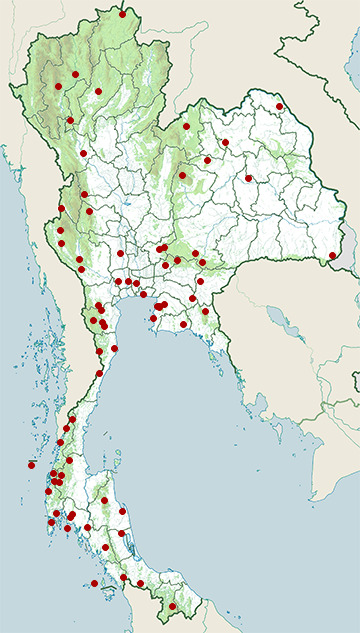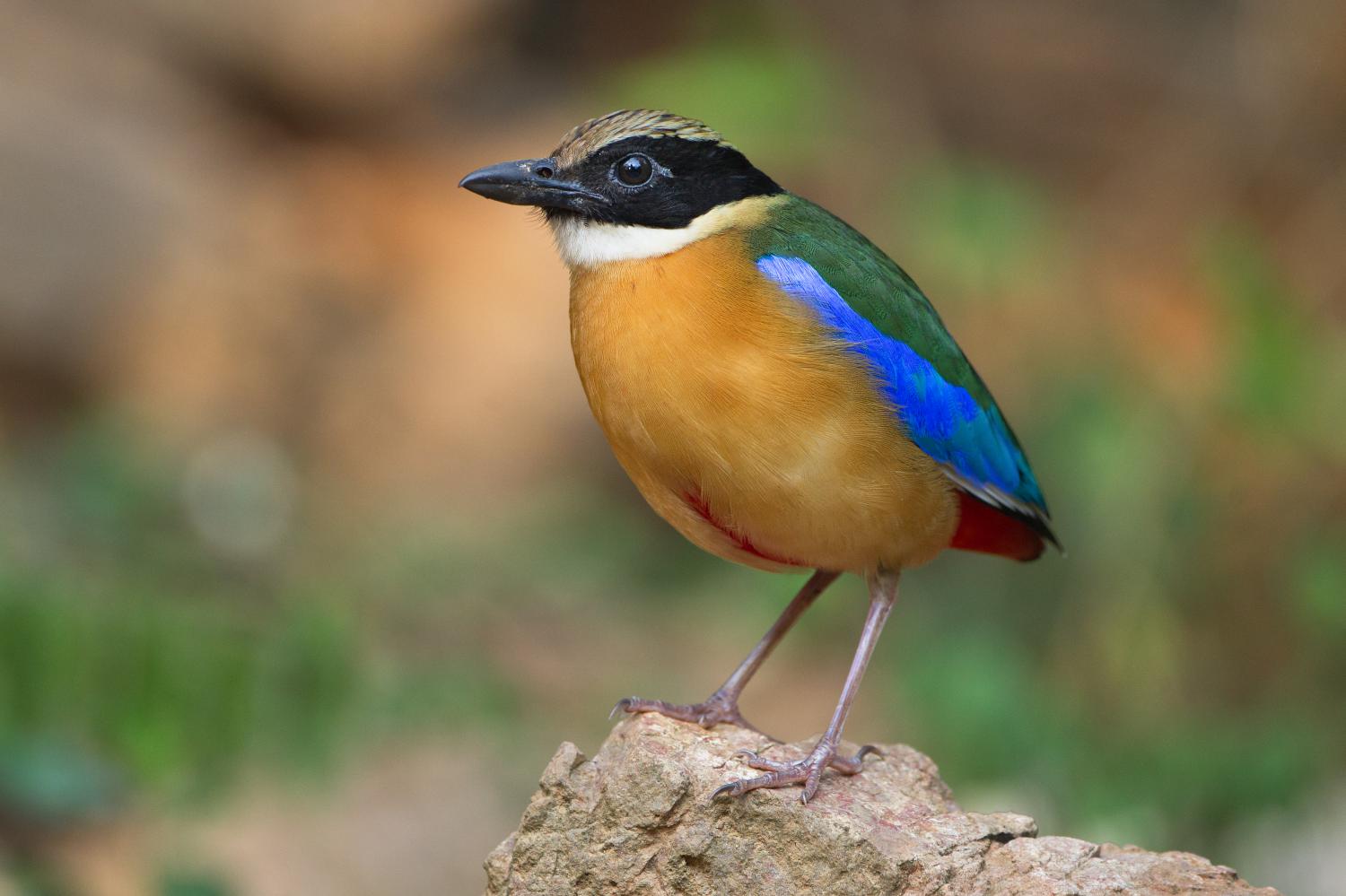Species of Thailand
Blue-winged pitta
Pitta moluccensis
Philipp Ludwig Statius Müller, 1776
In Thai: นกแต้วแล้วธรรมดา
The blue-winged pitta (Pitta moluccensis) is a passerine bird in the family Pittidae and Southeast Asia. It forms a superspecies with three other pittas, the Indian pitta (P. brachyura), the fairy pitta (P. nympha) and the mangrove pitta (P. megarhyncha). A colourful bird, it has a black head with a buff stripe above the eye, a white collar, greenish upper parts, blue wings, buff underparts and a reddish vent area. Its range extends from India to Malaysia, Indonesia, southern China and the Philippines. Its habitat is moist woodland, parks and gardens and it avoids dense forest. It feeds mainly on insects and worms. It breeds in the spring, building an untidy spherical nest on the ground, often near water and between tree roots. A clutch of about five eggs is laid and incubated by both parents, hatching after about sixteen days.
Taxonomy
The blue-winged pitta was described by the German naturalist Philipp Ludwig Statius Müller in 1776 and given the binomial name Turdus moluccensis. Statius Müller's description was based on a plate showing the "Merle des Moluques" published by Comte de Buffon in his Planches Enluminées D'Histoire Naturelle. The French name and the specific epithet moluccensis refer to the Moluccas (the Maluku Islands). This was an error as the range of the species does not extend as far east. The type locality was amended in 1963 to Malacca on the Malay Peninsula. The species is now placed in the genus Pitta that was introduced by the French ornithologist Louis Jean Pierre Vieillot in 1816. The species is monotypic.
The blue-winged pitta forms a superspecies with the Indian pitta (P. brachyura), fairy pitta (P. nympha) and mangrove pitta (P. megarhyncha). Alternate common names include: lesser blue-winged pitta, the little blue-winged pitta, the Moluccan pitta, the brève à ailes bleues (French), the Kleine Blauflügelpitta (German) and the pita aliazul (Spanish).
Description
Measuring 180 to(-) 205 mm in length, the blue-winged pitta has a black head with a buff-coloured supercilium, white chin and buff underparts. The shoulders and mantle are greenish, the wings are bright blue, and the vent is reddish. The bill is black, eyes are brown and the legs pale pink. It has a very short tail. Juveniles have similar patterned plumage but are duller. It resembles the mangrove pitta but can be distinguished by its shorter bill. The loud call has been transcribed as taew-laew taew-laew.
Distribution and habitat
The blue-winged pitta is regularly found in Brunei, Cambodia, China, India, Indonesia, Laos, Malaysia, Myanmar, the Philippines, Singapore, Thailand, and Vietnam, and has been found to be vagrant in Australia, Christmas Island, Taiwan and Hong Kong. Habitat is subtropical and tropical moist lowland forests.
P. moluccensis is found in a variety of habitats, up to an altitude of 800 m (2500 ft), including broadleaved forests, parks and gardens, and mangroves, though avoids dense rainforest.
The range is much of southeast Asia and Indochina, from central Myanmar east through Thailand and into peninsular Malaysia. P. moluccensis is a winter visitor to Borneo and Sumatra, and a vagrant to the Philippines and Java. It is a rare vagrant to the northwestern coast of Australia.
Diet
The blue-winged pitta mostly feeds on worms and insects, hunting them on the ground or from a low branch or perch. They also eat hard-shelled snails.
Breeding
At breeding time, the blue-winged pitta builds a large nest, usually on the ground, made of twigs, roots, grasses, leaves and mosses. The spherical and untidy nest has a side entrance and is often found between tree roots near water. In its breeding range in peninsular Malaysia, the blue-winged pitta lays eggs between early May and late July each year. The female lays 4-6 white or cream-coloured eggs with purple markings, and both parents take turns incubating the eggs for 15–17 days.
This article uses material from Wikipedia released under the Creative Commons Attribution-Share-Alike Licence 3.0. Eventual photos shown in this page may or may not be from Wikipedia, please see the license details for photos in photo by-lines.
Category / Seasonal Status
Wiki listed status (concerning Thai population): Summer visitor, passage migrant
BCST Category: Recorded in an apparently wild state within the last 50 years
BCST Seasonal statuses:
- Breeding visitor
- Mainly spring and autumn passage migrant
Scientific classification
- Kingdom
- Animalia
- Phylum
- Chordata
- Class
- Aves
- Order
- Passeriformes
- Family
- Pittidae
- Genus
- Pitta
- Species
- Pitta moluccensis
Common names
- Thai: นกแต้วแล้วธรรมดา
Conservation status

Least Concern (IUCN3.1)
Photos
Please help us review the bird photos if wrong ones are used. We can be reached via our contact us page.
Range Map

- Ao Phang-Nga National Park
- Ban Bueng District, Chonburi
- Bang Lamung District, Chonburi
- Bang Lang National Park
- Bang Phra Non-Hunting Area
- Bang Pu Recreation Centre
- Bangkok Province
- Bueng Khong Long Non-Hunting Area
- Chaloem Phrakiat Thai Prachan National Park
- Chiang Saen District, Chiang Rai
- Doi Inthanon National Park
- Erawan National Park
- Huai Kha Khaeng Wildlife Sanctuary
- Huai Yang Waterfall National Park
- Kaeng Khoi District, Saraburi
- Kaeng Krachan District, Phetchaburi
- Kaeng Krachan National Park
- Kaeng Krung National Park
- Kantharawichai District, Maha Sarakham
- Khao Ang Rue Nai Wildlife Sanctuary
- Khao Khiao - Khao Chomphu Wildlife Sanctuary
- Khao Laem National Park
- Khao Luang National Park
- Khao Nam Khang National Park
- Khao Phanom Bencha National Park
- Khao Phra - Bang Khram Wildlife Sanctuary
- Khao Phra Thaeo Wildlife Sanctuary
- Khao Sam Roi Yot National Park
- Khao Soi Dao Wildlife Sanctuary
- Khao Sok National Park
- Khao Yai National Park
- Khlong Saeng Wildlife Sanctuary
- Khura Buri District, Phang Nga
- Klaeng District, Rayong
- Kra Buri District, Ranong
- Kromluang Chumphon Wildlife Sanctuary
- Kui Buri National Park
- Mae Ping National Park
- Mae Wong National Park
- Muak Lek District, Saraburi
- Mueang Chiang Mai District, Chiang Mai
- Mueang Krabi District, Krabi
- Mueang Lampang District, Lampang
- Mueang Loei District, Loei
- Mueang Nakhon Nayok District, Nakhon Nayok
- Mueang Nakhon Pathom District, Nakhon Pathom
- Mueang Ranong District, Ranong
- Mueang Sa Kaeo District, Sa Kaeo
- Mueang Suphanburi District, Suphan Buri
- Mueang Tak District, Tak
- Nong Ya Plong District, Phetchaburi
- Pak Phanang District, Nakhon Si Thammarat
- Phi Phi Islands
- Phu Chong Na Yoi National Park
- Phu Foi Lom National Park
- Phu Khiao Wildlife Sanctuary
- Phu Wiang National Park
- Phutthamonthon District, Nakhon Pathom
- Sai Yok District, Kanchanaburi
- Sakaerat Environmental Research Station
- Si Racha District, Chonburi
- Sri Phang Nga National Park
- Surin Islands
- Takua Pa District, Phang Nga
- Tarutao National Marine Park
- Tha Yang District, Phetchaburi
- Thale Ban National Park
- Thale Noi Non-Hunting Area
- Thap Lan National Park
- Thong Pha Phum District, Kanchanaburi
- Thung Yai Naresuan Wildlife Sanctuary
- Yan Ta Khao District, Trang
